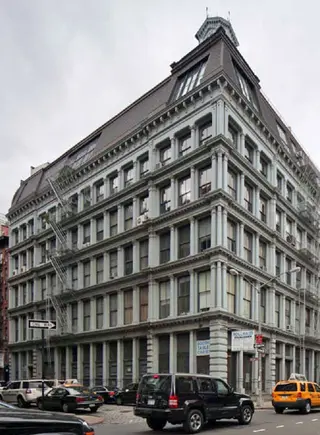 Carter Horsley
Carter HorsleyJul 12, 2016
Carter's Review
This imposing cast-iron building in SoHo was erected in 1869 and designed by William Field & Son for Charles C. Hastings as a warehouse.
According to the SoHo Historic District Designation Report, “over the years, the building was occupied by a variety of commercial interests, including Benedict Hall & Co., boot makers (1874); Hinck & Co., dry goods (1879); St. John-Kirham Shoe Co. (1890); Metropolitan Tobacco Co. (1900); Demerer Bros., ladies hand bags (1921); Daniel Jones, Inc., furniture manufacture and repair (1942-1962); and the Hercules Drop Cloth Co. (1970).
In 1937, Ely Jacques Kahn, the architect, designed a major remodeling of the building but the plan was not carried out.
The mansard roof was striped in 1962, but was partially restored in 2004.
The upper floors of the building, which is also known as 23-29 Crosby Street, were converted to residential use in 1977 by Peter Gee, who, according to Streeteasy.com, was a well-known British-born artist active in pop art in the 1960s.
It has 17 co-operative apartments in two buildings on the site.
Bottom Line
With its one-story rusticated base beneath five large tiers with large indented windows under a mansard roof, this 19th Century, cast-iron structure is one of the most imposing buildings in SoHo.
Description
The building replaced the Grand Street Presbyterian Church.
It’s large, inset window openings flanked by Corinthian columns, its rusticated first-story piers, bracketed cornices, and large mansard roof are indicative of the Second Empire style as it was typically applied to large, cast-iron commercial buildings of its day. The mansard roof was enlarged by owned C. C. Hastings in 1962 to designs by M. J. Fryer Jr. and the cornice was partially removed and the roof was altered in2004 with the mansard roof being partially restored.
The historic district’s designation report contains a photograph of the building circa 1915 from the New York Public Library showing the extremely attractive groupings of arched windows above the cornice and the curved slope of the roof, elements replaced brutally with an enlarged and slanted roofline with large angled skylights.
The building has fire-escapes on two of its major façades.
Apartments
Ceiling heights are 12 feet and higher.
Apartment 5FR is a one-bedroom unit with an entry foyer next to an open, pass-through, 20-foot-long kitchen adjacent to the 46-by-38-foot living area.
Apartment 3WF is a two-bedroom unit with a 15-foot-wide entry foyer that leads around the 14-foot-wide, open kitchen with an island to the 47-foot-long living room.

- Co-op built in 1869
- Located in SoHo
- 17 total apartments 17 total apartments
- 10 recent sales ($1.5M to $8M)
- Pets Allowed
 6sqft delivers the latest on real estate, architecture, and design, straight from New York City.
6sqft delivers the latest on real estate, architecture, and design, straight from New York City.
